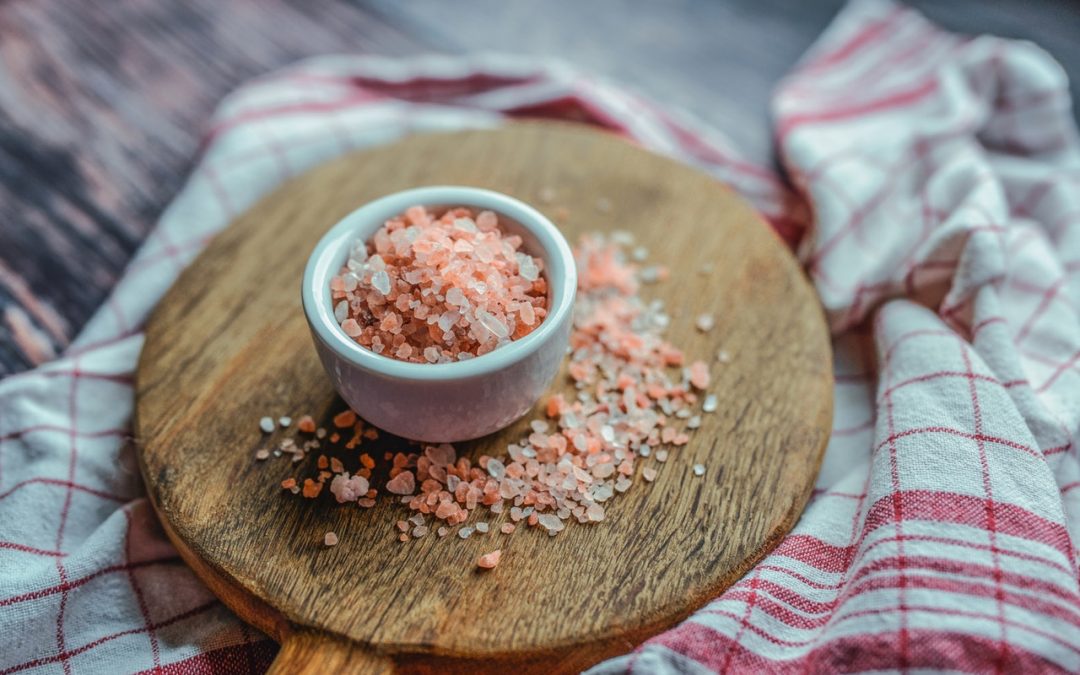Pink Himalayan salt is often said to be the most beneficial as well as the cleanest salt available on this planet today. It has all kinds of nutritional and therapeutic properties, not to mention culinary Himalayan pink salt uses.
You can use it as a healthier option to processed salt. You can also use it to create homemade body scrubs and bath soaks, and you may have seen or even already own a pink Himalayan salt lamp.
Historically, the people of the Himalayas have used this versatile salt to preserve meat and fish.
Is salt bad for you? As scientific research has pointed out, “US Dietary Guidelines recommend a daily sodium intake 2300 mg, but evidence linking sodium intake to mortality outcomes is scant and inconsistent.”
The right salt in the right amount can actually be very good for your health (much more on this to come).
Himalayan salt minerals are very impressive. Pink Himalayan sea salt can contain over 84 minerals and trace elements, including calcium, magnesium, potassium, copper and iron, so it does more than just make your food taste better.
Let’s look at why you may want to make the switch to pink Himalayan salt for the its impressive health benefits. Instead of skipping salt all together, why not give it an upgrade?
What Is Pink Himalayan Salt?
In general, salt is essential for maintaining healthy functioning of the body’s cells, nerve conduction, digestion, as well as the absorption of nutrients and the elimination of waste products.
Pink Himalayan salt is a truly unique salt. It’s also referred to as pink salt, Himalayan sea salt, rock salt and Himalayan crystal salt.
With a history dating back to Earth’s creation, Himalayan salt is believed to be composed of dried remnants of the original, primal sea.
What is Himalayan pink salt? This salt is classified as rock salt or halite, which comes from the Punjab region of Pakistan about 190 miles from the Himalayas.
This region has one of the richest salt fields in the entire world, and they are very, very old. I’m talking Precambrian age or over 4 billion years ago when planet Earth first formed!
Himalayan crystal salt comes from salt mines 5,000 feet deep below the Himalayan Mountain Range. The salt from these mines has experienced tremendous pressure over millions of years and is said to be over 99 percent pure.
Pink Himalayan salt’s color as well as its color variations are indicative of its mineral content. Himalayan crystal salt can be pink, white or red in color.
As a salt, pink Himalayan salt is chemically sodium chloride (NaCl), which is defined as a “mineral substance of great importance to human and animal health.”
If you’re looking to compare pink Himalayan salt vs. sea salt, pink Himalayan salt is a type of sea salt. Another type of sea salt like Celtic sea salt is comparable to Himalayan crystal salt in its composition and health benefits, but it’s a completely different salt that comes from a different source (Brittany, France), has a different color (grayish) and a different mineral makeup.
Many Himalayan salt companies say that Himalayan pink salt contains 84 trace minerals, but there is debate that both types of sea salts contain around 60 minerals. Either way, they both contain minerals in small amounts.
Conclusion: Pink Himalayan salt is a type of sea salt and generally speaking, sea salts contain valuable minerals. The type and amounts of these minerals can naturally vary depending upon the source of the sea salt.
Why Is It Better than Table Salt?
Pink Himalayan salt is a much more balanced and healthy choice in comparison to common table salt. True, high-quality pink Himalayan salt is one of the purest salts you can find.
It’s even typically mined by hand. This is very different from table salt that involves a great deal of unnatural interference.
Table salt is very heavily processed, eliminating its minerals and only makes the list of iodine sources because it has added iodine. Commercial table salt is typically 97.5 percent to 99.9 percent sodium chloride.
Meanwhile, a high-quality unrefined salt like Himalayan sea salt may be only about 87 percent sodium chloride.
With most table salts, you’re only left with one mineral (sodium), some added iodine and most often some really health-hazardous anti-clumping agent like yellow prussiate of soda.
Himalayan salt minerals typically include calcium, magnesium, potassium, copper and iron.
Does pink Himalayan salt have iodine? While Himalayan salt nutrition can be impressive, like other sea salts, Himalayan salt iodine content is typically very low if at all so it’s not a good source of this nutrient and you’re better off consuming iodine-rich foods to obtain this nutrient.
Many commercial table salts also undergo a bleaching process and contain aluminum derivatives and other terrible ingredients known to be highly toxic to human health.
Conclusion:
Himalayan pink salt is often mined by hand and very pure while table salt is far from its natural state and very heavily processed. Other than sodium, the only nutrient table salt contains is added iodine.
Meanwhile, Himalayan salt nutrition contains various minerals in small amounts such as calcium, magnesium, potassium, copper and iron.
